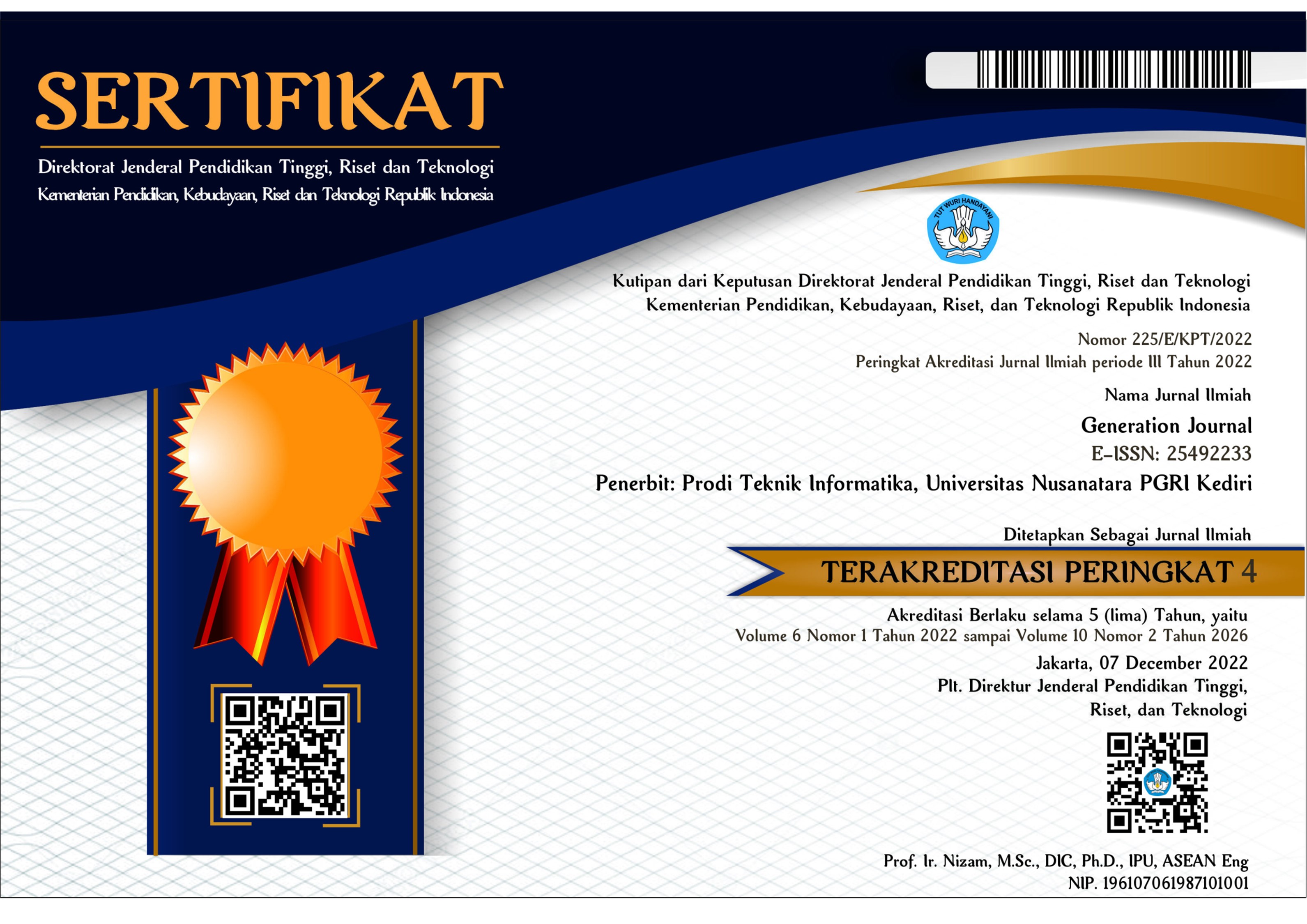Klasifikasi Kematangan Buah Tomat Dengan Metode Support Vector Machine
DOI:
https://doi.org/10.29407/gj.v7i3.21092Keywords:
color moment, GLCM, SVM, tomatoAbstract
Kematangan tomat memainkan peran penting dalam menentukan kualitas dan daya tahan produk tomat. Pada umumnya, klasifikasi kematangan tomat dilakukan secara visual oleh para ahli atau petani berdasarkan pengalaman mereka. Dalam penelitian ini, metode klasifikasi kematangan tomat berbasis citra digunakan dengan menerapkan fitur Gray-Level Co-occurrence Matrix (GLCM) dan momen warna, serta metode Support Vector Machine (SVM). Hasil penelitian menunjukkan bahwa model SVM dengan fitur GLCM dan Momen Warna menghasilkan Accuration dan Precission sebesar 0,91, serta nilai recall dan F-Measure sebesar 0,92akurasi sebesar 91.1%, yang termasuk dalam kategori baik. Beberapa kesalahan klasifikasi pada beberapa citra, yang disebabkan oleh dominansi warna yang tidak sesuai pada kategori yang seharusnya
References
I. O. Angelia, “Efektivitas Pelilinan Terhadap Perubahan Kualitas Warna Buah Tomat (Solanum lycopersicum),” Seminar Nasional Teknologi, Sains dan Humaniora (SemanTECH), vol. 1, no. 5, 2021.
P. Eka and P. Ariati, “Produksi Beberapa Tanaman Sayuran dengan Sistem Vertikultur di Lahan Pekarangan,” Agrimeta, vol. 7, no. 13, 2017.
M. A. Anggriawan, M. Ichwan, and D. B. Utami, “Pengenalan Tingkat Kematangan Tomat Berdasarkan Citra Warna Pada Studi Kasus Pembangunan Sistem Pemilihan Otomatis,” Jurnal Teknik Informatika dan Sistem Informasi, vol. 3, no. 3, 2017, doi: 10.28932/jutisi.v3i3.688.
A. Kurniasari, D. Erwanto, and P. N. Rahayu, “Ekstraksi Fitur Tekstur dan Warna pada Kulit Katak Menggunakan GLCM dan Momen Warna,” Jurnal ELTIKOM, vol. 6, no. 1, 2022, doi: 10.31961/eltikom.v6i1.287.
I. Kurnia Sari and N. Muniroh, “PENERAPAN NILAI RATA-RATA RGB PADA APLIKASI PENGUKUR KEMATANGAN BUAH TOMAT,” Jurnal Teknologi dan Bisnis, vol. 2, no. 2, 2021, doi: 10.37087/jtb.v2i2.27.
N. I. Humaira B, M. Herman, N. Nurhikma, and A. B. Kaswar, “KLASIFIKASI TINGKAT KUALITAS DAN KEMATANGAN BUAH TOMAT BERDASARKAN FITUR WARNA MENGGUNAKAN JARINGAN SYARAF TIRUAN,” Journal of Embedded Systems, Security and Intelligent Systems, vol. 2, no. 1, 2021, doi: 10.26858/jessi.v2i1.20329.
H. Mubarok, S. Murni, and M. M. Santoni, “Penerapan Algoritma K-Nearest Neighbor untuk Klasifikasi Tingkat Kematangan Buah Tomat Berdasarkan Fitur Warna,” Seminar Nasional Mahasiswa Ilmu Komputer dan Aplikasinya (SENAMIKA) Jakarta-Indonesia, 2021.
S. Aprilisa, J. Magister, I. Komputer, and S. J. Magister, “Klasifikasi Tingkat Kematangan Buah Tomat Berdasarkan Fitur Warna Menggunakan K-Nearest Neighhbor,” Annual Research Seminar (ARS), vol. 5, no. 1, 2020.
B. O. Hua, M. A. Fu-Long, and J. Li-Cheng, “Research on computation of GLCM of image texture,” Acta Electronica Sinica, vol. 1, no. 1, pp. 155–158, 2006.
M. Erfan, D. Erwanto, and P. N. Rahayu, “Ekstraksi Fitur Warna dan Tekstur Pada Kulit Katak Menggunakan Metode Momen Warna dan CCM,” Setrum: Sistem Kendali-Tenaga-elektronika-telekomunikasi-komputer, vol. 9, no. 2, 2020.
M. D. Agaputra, K. R. R. Wardani, and E. Siswanto, “Pencarian Citra Digital Berbasiskan Konten dengan Ekstraksi Fitur HSV, ACD, dan GLCM,” Jurnal Telematika, vol. 8, no. 2, p. 8, 2013.
E. P. Purwandari, D. Andreswari, and U. Faraditha, “Ekstraksi Fitur Warna dan Tekstur Untuk Temu Kembali Citra Batik Besurek,” Pseudocode, vol. 7, no. 1, pp. 17–25, 2020.
A. S. Nugroho, A. B. Witarto, and D. Handoko, “Support Vector Machine – Teori dan Aplikasinya dalam Bioinformatika,” Kuliah Umum IlmuKomputer.Com, 2003.
I. P. G. S. Pradnyana, L. Novamizanti, and H. Fauzi, “Perancangan Sistem Pendeteksi Genangan Air Potensi Perkembangbiakan Nyamuk Melalui Foto Citra Udara Dengan Metode Gray Level Co-occurrence Matrix (glcm),” eProceedings of Engineering, vol. 2, no. 2, 2015.
M. Hall-Beyer, “GLCM texture: a tutorial,” National Council on Geographic Information and Analysis Remote Sensing Core Curriculum, vol. 3, no. 1, p. 75, 2000.
P. Mohanaiah, P. Sathyanarayana, and L. GuruKumar, “Image texture feature extraction using GLCM approach,” International journal of scientific and research publications, vol. 3, no. 5, p. 1, 2013.
M. I. Thusnavis Bella and A. Vasuki, “An efficient image retrieval framework using fused information feature,” Computers and Electrical Engineering, vol. 75, 2019, doi: 10.1016/j.compeleceng.2019.01.022.
N. Keen, “Color moments,” School of informatics, University of Edinburgh, pp. 3–6, 2005.
V. Blanco, A. Japón, and J. Puerto, “Optimal arrangements of hyperplanes for SVM-based multiclass
classification,” Adv Data Anal Classif, vol. 14, no. 1, 2020, doi: 10.1007/s11634-019-00367-6.
JavaTpoint, “Support Vector Machine Algorithm,” JavaTpoint.
Downloads
Published
Issue
Section
License
Authors who publish with this journal agree to the following terms:
- Copyright on any article is retained by the author(s).
- The author grants the journal, the right of first publication with the work simultaneously licensed under a Creative Commons Attribution License that allows others to share the work with an acknowledgment of the work’s authorship and initial publication in this journal.
- Authors are able to enter into separate, additional contractual arrangements for the non-exclusive distribution of the journal’s published version of the work (e.g., post it to an institutional repository or publish it in a book), with an acknowledgment of its initial publication in this journal.
- Authors are permitted and encouraged to post their work online (e.g., in institutional repositories or on their website) prior to and during the submission process, as it can lead to productive exchanges, as well as earlier and greater citation of published work.
- The article and any associated published material is distributed under the Creative Commons Attribution-ShareAlike 4.0 International License













